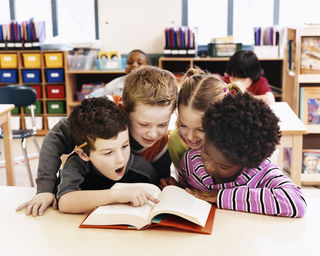Relationships
Why a Child’s Social-Emotional Skills Are So Important
Here are five ways you can promote these abilities in children.
Posted January 30, 2017 Reviewed by Ekua Hagan
Imagine you are 4 years old. You are given the choice of eating one marshmallow now or receiving two marshmallows if you wait. What would you do?

In a now-famous series of studies, Walter Mischel and colleagues (Mischel, Ebbesen & Zeiss, 1972; Mischel, Shoda, & Peake, 1988) had preschool and school-age participants make this decision. This research taught us that children who were able to delay eating the marshmallows to obtain the larger prize were more likely to do well in school and in their careers for decades following the study.
This ability to delay gratification and regulate our emotions and behavior is a key component of a set of skills often referred to as social-emotional skills. In a world where academic skills are often viewed as the priority, social-emotional skill development may not always be at the forefront of most parents’ and teachers’ minds. However, research has shown that social-emotional skills are crucial for children to become successful both socially and academically.
What are the key social and emotional skills?
The Collaborative for Academic, Social, and Emotional Learning has identified five core skills that are widely recognized as critical social-emotional skills:
- Self-awareness is the ability to recognize your emotions and understand the links between emotions, thoughts and behaviors.
- Self-management is the ability to regulate emotions, thoughts and behaviors.
- Social awareness is the ability to take other’s perspectives and demonstrate empathy.
- Relationship skills are the ability to build and maintain healthy relationships.
- Responsible decision making is the ability to make good choices about your behavior and interactions with others.
Why are social-emotional skills important?
Early social-emotional skills are related to how socially, emotionally, academically and professionally skilled we are later in life. For example, having higher social-emotional skills in kindergarten is related to important outcomes at age 25 (Jones, Greenberg, & Crowley, 2015). These outcomes include:
- Educational success, such as completing a college degree
- Career success, such as an increased likelihood of being employed
- Other key life outcomes, such as being less likely to have problems with the police
Social-emotional skills help children to persist on challenging tasks, to effectively seek help when they need it and to be thoughtful in their actions.
Importantly, social-emotional skills can be taught. This was highlighted in a large review of research on social-emotional skills in 270,034 students in kindergarten through 12th grade (Durlak et al., 2011). The review found social-emotional learning programs in schools not only improved social-emotional skills, but also increased positive attitudes toward school, positive social behavior and academic performance. These programs also decreased the likelihood of kids getting in trouble or experiencing emotional problems.
Five strategies for promoting social-emotional learning in children
- Be a good emotional role model. Children model their behavior from people they admire, such as their parents and teachers. When caregivers model a variety of emotions and coping strategies to manage their emotions, children learn appropriate ways to react in similar circumstances.
- Be an “emotion coach.” Accept and talk about children’s emotions. It is also useful to teach children how to label emotions, cope with and problem-solve emotions, and appropriately express emotions. Emotion coaching is associated with greater emotion regulation and adaptive behaviors as well as lower levels of disruptive behaviors (Dusnmore, Booker, & Ollendick, 2013; Gottman, Katz, & Hooven, 1996).
- Read books with social-emotional plots. Reading books can provide opportunities to learn and discuss social-emotional topics, such as turn-taking and cooperation. Asking children to label and explain the emotions of the characters in the story helps them learn a variety of emotions (Brownell, et al., 2013).
- Give choices. Providing children with choices and the independence to make them are linked to higher levels of social-emotional learning. A parent-child relationship that involves working together to solve problems teaches children how to negotiate and solve problems with parents, which later leads to improved social skills and higher acceptance in relationships with peers (Matte-Gagné, Harvey, & Stack, 2015).
- Use positive discipline strategies. Setting rules and expectations for behavior, giving warnings of potential consequences, offering praise and incentives for positive behaviors and ignoring unwanted behavior are associated with higher levels of social-emotional skills (LaRosa, Ogg, Suldo, & Dedrick, 2016). When children act out, discuss the effects of their behavior on others to promote empathy, perspective-taking and prosocial behavior (Eisenberg, VanSchyndel & Hofer, 2015).
There is a common theme in these strategies. Children need to be taught and to have opportunities to practice social-emotional skills, in much the same way that they learn how to read and solve math problems.
These efforts come with a big payoff, as strong social-emotional skills can help children in a wide variety of social and academic settings for years to come.
By guest contributors Julia Ogg, Katelynn Gohr, and Kayla LaRosa: Julia Ogg Ph.D., is an assistant professor of psychology at Northern Illinois University. Katelynn Gohr is a second-year master’s student in school psychology at Northern Illinois University. Kayla LaRosa is a third-year doctoral student in school psychology at the University of South Florida.
References
Brownell, C. A., Svetlova, M., Anderson, R., Nichols, S. R., & Drummond, J. (2013). Socialization of early prosocial behavior: Parents’ talk about emotions is associated with sharing and helping in toddlers. Infancy, 18, 91-119. doi: 10.1111/j.1532-7078.2012.00125.x.
Dunsmore, J. C., Booker, J. A., & Ollendick, T. H. (2013). Parental emotion coaching and child emotion regulation as protective factors for children with oppositional defiant disorder. Social Development, 22, 444-466. doi:10.1111/j.1467-9507.2011.00652.x
Durlak, J. A., Weissberg, R. P., Dymnicki, A. B., Taylor, R. D., & Schellinger, K. B. (2011). The impact of enhancing students’ social and emotional learning: A meta-analysis of school-based universal interventions. Child Development, 821, 405-432.
Eisenberg, N. VanSchyndel, S. K., & Hofer, C. (2015). The association of material socialization in childhood and adolescence with adult offsprings’ sympathy/caring. Developmental Psychology, 51, 7-16.
Gottman, J. M., Katz, L. F., & Hooven, C. (1996). Parental meta-emotion philosophy and the emotional life of families: Theoretical models and preliminary data. Journal of Family Psychology, 10, 284–291.
Jones, D. E., Greenberg, M., & Crowley, M. (2015). Early social-emotional functioning and public health: The relationship between kindergarten social competence and future wellness. American Journal of Public Health, 105, 2283-2290.
LaRosa, K., Ogg, J., Suldo, S. & Dedrick, R. (2016). Parent predictors of social-emotional strengths in kindergartners (Unpublished thesis). University of South Florida, Tampa, FL.
Matte-Gagné, C., Harvey, B., Stack, D.M., & Serbin, L. A. (2015). Contextual Specificity in the Relationship between Maternal Autonomy Support and Children’s Socio-emotional Development: A Longitudinal Study from Preschool to Preadolescence. Journal of Youth and Adolescence, 44, 1528-1541. doi:10.1007/s10964-014-0247-z
Mischel, W, Ebbesen, E. B., & Zeiss, A. R. (1972). Cognitive and attentional mechanisms in delay of gratification. Journal of Personality and Social Psychology, 21, 204-218.
Mischel, W, Shoda, Y, & Peake, P. K. (1988). The nature of adolescent competencies predicted by preschool delay of gratification. Journal of Personality and Social Psychology, 54, 687-69


